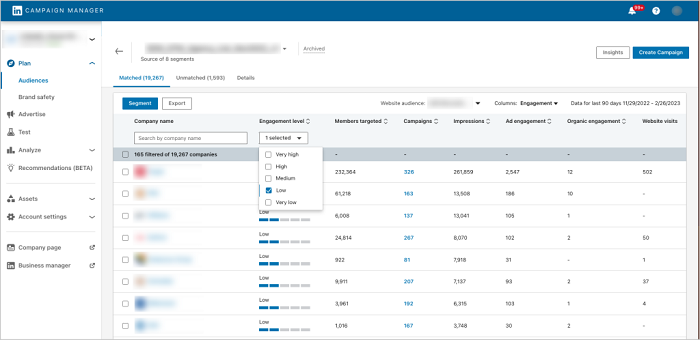SOCIAL
LinkedIn Provides New Segmentation Options for its Company Engagement Report

LinkedIn has announced some new updates to its Company Engagement Report, which will provide more in-depth data on how your LinkedIn content is reaching employees from specific companies that you’re looking to connect with.
LinkedIn’s Company Engagement Report, which is available within the Matched Audience element of Campaign Manager, shows you how many people from each company are engaging with your content. Which can be handy intel for focusing your outreach – though it’s only available to brands that have used LinkedIn ads or have uploaded a matched list.
If that’s your business, then you now have some new options to explore the data contained with the report.
Company Segmentation will enable marketers to filter the report to create company list segments, which can then be used in outreach campaigns.
As explained by LinkedIn:
“Once you’ve filtered by engagement level and prioritized accounts for your segment, you will have the option to create a dynamic or static segment. A dynamic segment will update daily with companies from your original list that have low engagement. A static segment will be a snapshot of the low engaged companies at that moment and the segment of companies will not change.”
In other words, you’ll have more ways to categorize each segment of your list specifically, which will then enable more nuanced outreach and advertising, based on relative engagement.
“Run a full-funnel marketing campaign utilizing dynamic segments by creating tiers aimed at different audience segments focused on awareness, consideration, and conversion, and tailor your content to align with each stage. Direct the awareness tier toward your target audience with very low engagement, the consideration tier at the segment with low to medium engagement, and the conversion tier at the segment with high and very high engagement.”
You can also download the Company Engagement Report to conduct your own analysis, providing more ways to categorize and utilize your LinkedIn engagement data.
The additional capabilities will make this a more valuable consideration. And while it won’t be a key factor for all brands, for those that are using the platform’s more in-depth analysis tools, it could be a great way to glean more specific insight into how people from your target brands are interacting, or not, with your updates.
More segmentation leads to better targeting, and more tools to facilitate such can only help.
You can read more about LinkedIn’s updates to its Company Engagement Report here.















